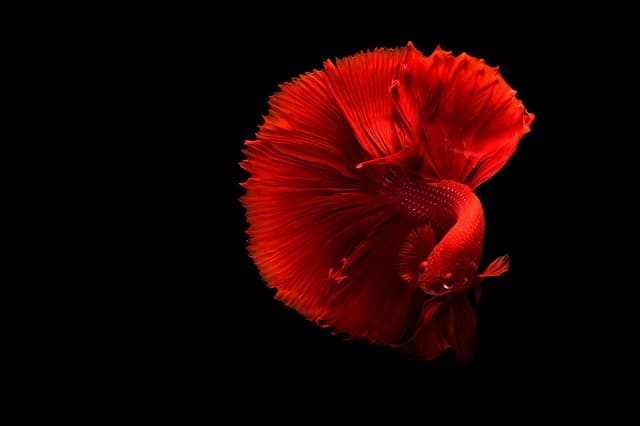GloFish are an aquatic phenomenon and highly popular in the aquarist world! Their unique coloring makes them appear to ‘glow in the dark’ and has piqued the interest of many aquarium hobbyists. But what makes them glow, exactly?
The fluorescent color in GloFish is created by an inherited bio-luminescent protein gene that is passed down from generation to generation. It began with green fluorescent proteins found naturally in sea anemones and jellyfish that were injected into zebra danios 20 years ago by scientists in Singapore.
Now that you know what it is that makes GloFish glow, let’s ‘dive deeper’ into this intriguing topic. Together we’ll discover what species form the GloFish community, where they come from, if they’re natural or man-made, if they’re salt or freshwater fish, what to feed them to help to enhance coloration, if they need light to glow, and what tank conditions are required.
So, if you’re ready to learn all you need to know about the amazing phosphorescent marvel that is the GloFish, then let’s begin!
What are GloFish?
GloFish are a patented, trademarked brand of bio-luminescent aquarium fish. They’re created from several different species but originated with genetically enhanced zebrafish. These fish are renowned for their ability to ‘glow in the dark’ in fluorescent shades of green, blue, pink, purple, red, and orange.
Where do GloFish Come From?
GloFish originally came from Singapore about 20 years ago. Scientists injected zebra danios with jellyfish and/or sea anemone proteins to make them ‘glow.’ The idea was to help biologists determine which waterways in India were contaminated – if the fish glowed, it meant there were pollutants in the water.
Nowadays, GloFish are captive-bred and naturally brilliant. They can be found in most local pet shops and are usually of the tetra variety. The purchase price runs anywhere from $10-20, depending on the size, species, and color of the fish.
Are GloFish Man-Made?
GloFish are different species of fish that have been genetically modified by scientists to create brighter, more vibrant versions of themselves. Sea anemone and jellyfish genes are typically used to enhance the popular bright green, blue, and pink shades of GloFish.

Are GloFish Injected with Color?
GloFish of today are born brilliant! They aren’t dyed, injected, or altered in any way. Instead, they get their luminescent coloring naturally through heredity. Parent fish pass down the fluorescent gene to their offspring which is then transferred through the reproductive process.
Why are GloFish Different Colors?
GloFish come in 6 shades: electric green, cosmic blue, galactic purple, moonrise pink, sunburst orange, and starfire red. Each GloFish inherits its unique coloring from its parents and will maintain its vibrancy throughout its lifespan, even passing their fluorescent traits to their offspring.
What Protein Makes GloFish Glow?
A protein known as GFP (green fluorescent protein) is what makes GloFish glow. It originates in jellyfish and produces the unique, bright ‘glow in the dark’ shade. This protein can also be found in other marine organisms including sea anemones.
Do GloFish Need a Light to Glow?
GloFish won’t ‘glow’ unless they’re illuminated with UV light. These fish absorb UV rays and they re-emit them, giving that ‘glow in the dark’ appearance. An adjustable LED aquarium light with an ambient or blue bulb (actinic) feature is required to fully enhance their vibrancy. Black lights will also do the trick.
Check out the following adjustable LED aquarium lights for glofish available online through Amazon.
Do GloFish Babies Glow?
GloFish babies will ‘glow’ just like their parents, though their brightness may be diminished with each new generation. When captive-bred, these fish tend to dull and appear to look more like that of their origin species, be it zebra danio or tetra.
What Species are GloFish?
GloFish are made up of different species of fish including bettas, rainbow sharks, tetras, tiger barbs, and zebra danios. Zebrafish were the original species of GloFish, genetically modified about 2 decades ago by marine biologists in Singapore.
Are GloFish Salt or Freshwater?
Since GloFish are type of freshwater fish, they can’t be kept in a saltwater tank. The salt would cause them to dehydrate, shrivel up, and die on account of the hypertonic environment. Some aquarium hobbyists will add a small amount of salt to their freshwater tank to help keep nitrite levels at bay.
What Tank Conditions are Best for GloFish?
Tank size and water parameters play a major role in the health and longevity of GloFish. Since these fish tend to be schooling and highly active, they should be kept in groups of at least 5 in a 10-gallon tank minimum. Add 2 gallons of water for each addition fish you have.
GloFish prefer tropical water conditions and should be kept in an environment ranging from 72- to 80-degrees Fahrenheit. They can survive in cooler temperatures of around 65-degrees but will be healthier and more active if kept in warmer water. Therefore, a heater is required.
GloFish prefer slightly acidic water with a pH of 7 to 8. Using a dechlorinating agent like Tetra Aqua Safe Plus water conditioner instead of salt when doing partial water changes (15-25% per week) will help to reduce toxins and keep the water safe.
GloFish, like most other fish, need light. They should be kept in an area with indirect sunlight or under a lamp – if you don’t have an aquarium light – for 12 hours a day. The other 12 hours should be in darkness to replicate the natural day/night cycle.
I’d recommend an adjustable LED aquarium light with a blue light feature. It replicates moonlight and won’t alter the natural day/night cycle of the fish. It’ll also helps illuminate your GloFish during the evening so you can extend your viewing hours.
What to Feed GloFish to Make Them Glow?
Feeding GloFish a varied, well-balanced diet of flakes, pellets, and freeze-dried foods will help keep them healthy and vibrant. Edibles rich in carotenoids will boost their brightness and coloration. GloFish Special Flake Food, available in-store at your local pet shop, is a great example.
Ulva seaweed (better known as sea lettuce) is a type of green macro-algae that’s rich in vitamin A, B6, B12, C and E as well as iron, niacin, and magnesium. It’s also high in beta carotene which helps enhance GloFish coloring, especially those of the red, orange, and pink variety.
GloFish should be fed once or twice per day with just enough food to eat in a 2- to 3-minute time-period. Don’t overfeed or you run the risk of contaminating your tank. These omnivores will thrive on a diet of plant- and meat-based foods.
Why are GloFish Controversial?
GloFish are often a topic of conversation in the aquarium industry. The controversy surrounding them dates to their genetically modified origin. Injected with genes snatched from other living sea creatures, some feel they’re an ecological hazard, which simply isn’t the case.
Final Thoughts
To conclude, the fluorescent color in GloFish was created 20 years ago by scientists in Singapore who injected zebra danios with jellyfish protein to test the purity of waterways in India. Today, these fish are naturally brilliant and ‘glow’ because of a bio-luminescent protein passed down to them genetically.
I trust this article has been of help in answering your questions about GloFish. Thanks for reading. Best of luck with your aquarist hobby.
Recommended Posts
Can a GloFish Live with Normal Fish?






